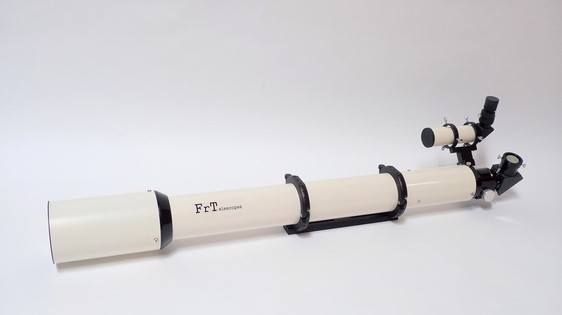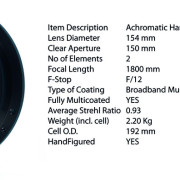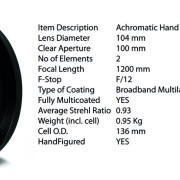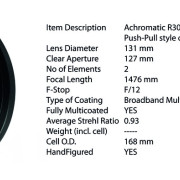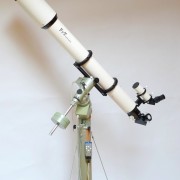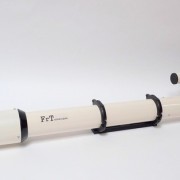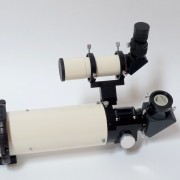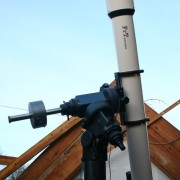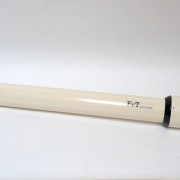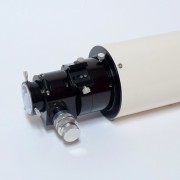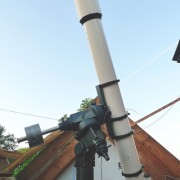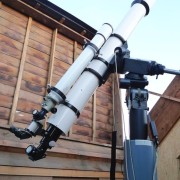FrT REFRACTORS
novembre 2013
INTRODUZIONE
Finalmente qualcuno ha il coraggio di rinverdire il fasto dei rifrattori acromatici classici a fuoco medio/lungo e di realizzare per loro una intubazione tradizionale in alluminio in grado di rendere il corretto servizio al doppietto dell’ottica senza gli inutili sprechi economici imposti dal carbonio e da altre soluzioni commercialmente valide quanto tecnicamente inutili su diametri contenuti come quelli proposti.
L’idea di realizzare una linea “custom made” di rifrattori partendo da doppietti in cella prodotti da terzi non è nuova e valutata anche da me in prima persona per divertimento e servigio alla comunità di amatori che esiste ancora e si ritrova compatta intorno a questi strumenti demodé ma ancora molto validi.
Il problema di base risiede, fondamentalmente, nell’identificare un produttore capace di fornire obiettivi di qualità elevata e costante. Oggi un tale “fornitore” è estremamente difficile da trovare. Piccole manifacturing esistono ma la loro produzione è artigianale e più indicata alla realizzazione di strumenti poco più che unici. Inoltre i tempi di delivery (ovverosia di approntamento e spedizione degli obiettivi) sono lunghi e incerti e farvi affidamento per una operazione micro-industriale è azzardato e foriero di non pochi grattacapi. Altri sono incorsi in problemi simili tanto che la loro quota di mercato è più insignificante che marginale, benché i loro prodotti siano sicuramente validi.
LA SCELTA DEL PRODUTTORE DI OTTICHE
La scelta operata da Frank Theys, patron di FrT, è quella sicuramente più facile e immediata. Istar è, oggi, il solo produttore (anzi rifinitore e ridistributore) di doppietti acromatici a fuoco medio esistente a livello internazionale e facilmente raggiungibile per accordi commerciali. In questo, Ales è decisamente bravo e aperto a patnership e la sua politica di immagine è più che azzeccata, con una ferma certezza delle proprie idee ma una rispettabile educazione nel modo di diffonderle.
Detto questo, personalmente non sono certo che i suoi doppietti rappresentino, almeno nelle versioni normali e non R30 o R35, ottiche di qualità pari a quelle di D&G o Lichtenknecker.
La mia esperienza con i doppietti ISTAR (comunque limitata a due esemplari) parla di doppietti di buona qualità, non eccelsa come vorrei, ma so anche che eminenti astrofili che hanno avuto modo di provare le nuove serie R30 e R35 ne sono rimasti favorevolmente colpiti.
All telescopes are F12 achromats with lenses from Istar Optical.
The tubes are of 2 mm thick extruded aluminum tubings finished in a gloss creamy white (RAL 9001) powdercoating, internally with 3 baffles of 2 mm thick aluminum and a black felt lining in the upper part of the tube, from the lens to the first baffle. The other parts are in deep black, resulting in the 'classic' look.
In order to avoid too much weight the dewcap is made of a lightweight epoxybased material that also has a better insulating capacity, resulting in a more delayed formation of dew compared to aluminum.
As focuser one of the better available focusers is selected : Moonlite.
In this case the 2" double speed version (larger is really not necessary for F12 optics) with 3 locking screws to securely fix even the heaviest accessories (f.i. binoviewer).
CHI E' FRANK THEYS? CE LO DICE LUI
Being a long time amateur astronomer I have some 35 years of practical experience in visual and photographic observing.
During this time a great many telescopes of different types and quality have passed through my hands so I have formed myself an opinion on which type of telescope I prefer for the different kinds of subjects : sun, moon, planets, deep-sky observing of galaxies, globulars, open starclusters, nebulae small and large....
The answer is : refractors, refractors, refractors, refractors, refractors,....
As far as I'm concerned, there is nothing more pleasing than the views through a refractor with its contrasty images and pinpoint stars, combined with its simplicity in use and its elegance.
I have been using apo's, semi-apo's and achromats of the small and large kind as well as of the short and long kind. Each one has its use but for moon and planetary observing I have come to really appreciate the views through long focal length achromatic refractors, because they seem to give stable views more often i.e. that they seem to be less affected by turbulences in the air. They do show the unavoidable CA but at F12 or F15 that is - in my opinion - not so bad.
At first it wasn't very clear to me why those views were so good, over the last 2 years there have been quite some debates on this subject for instance on the "Cloudy nights" forum where some very interesting points were made by Neil English (also author of the book "Choosing and using a refracting telescope"). There thus seem to be some possible explanations for their overall better image stabillity as percieved by some people, myself included.
Anyway, this to say that I was in the market for a long focal length achromatic telescope of 125 - 150 mm aperture. Only : that market was very sparse with telescopes either very expensive or with low availability or not to my liking so that in the end I decided to make my own telescope in the way that I wanted it.
While doing this I soon realised that in order to produce a decent telescope I needed some pieces to be custom made and powder-coated which made it quite expensive. It was obvious that those pieces would be much cheaper if made in larger quantities. Also, the hard part is first designing the telescope and all of it's pieces and then figuring out how to make them and from which material and then finally assemble them. If you can make one telescope it is fairly easy to make another and many more.
Thus was born the idea of starting my own little company in order to produce and sell the telescopes that I love myself, at a price that I can afford myself.
FrTelescopes is the result.
Frank Theys
LA GAMMA PRODOTTI
FrT100
Lens diameter : 100 mm
Focal ratio : F/12
Focal length f : 1200 mm
Total tube length : 1250 mm
Tube diameter : 110 mm
Telescope weight : 5.7 kg
936 Euro (VAT incl, OTA only)
FrT127
Lens diameter : 127 mm (*)
Focal ratio : F/12
Focal length f : 1470 mm
Total tube length : 1580 mm
Tube diameter : 140 mm
Telescope weight : 9.8 kg
1387 Euro (VAT incl, OTA only)
(*) Istar R30 lens with 30% reduction of CA through use of lanthanum glas, so equivalent to F/15.6
FrT150
Lens diameter : 150 mm
Focal ratio : F/12
Focal length f : 1800 mm
Total tube length : 1940 mm
Tube diameter : 158 mm
Telescope weight : 10.9 kg
1693 Euro (VAT incl, OTA only)
CONSIDERAZIONI SUI PREZZI E SUI "PEZZI"
Inutile dire che i prezzi esposti sono molto concorrenziali. E’ vero che il costo di partenza delle ottiche è contenuto (in quanto acromatici - per informazioni precise si può comunque scrivere a Frank stesso) ma è anche altrettanto vero che i focheggiatori proposti sono di buona qualità e che le finiture sembrano pulite.
La mia preferenza va ovviamente al 5 pollici anastigmatico, almeno sulla carta meglio corretto dal punto di vista cromatico e anche ben “centrato” come diametro per poter essere sfruttato nel maggior numero di sere possibili, anche dai nostri cieli con seeing ballerini.
UN TEST DEL RIFRATTORE FRT-100
Il solo test attualmente esistente su un rifrattore FRT è quello di Neil English che vi riporto:
